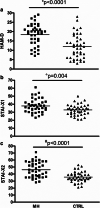Neurological soft signs are increased in migraine without aura: relationship with the affective status
- PMID: 35585436
- PMCID: PMC9474476
- DOI: 10.1007/s10072-022-06143-3
Neurological soft signs are increased in migraine without aura: relationship with the affective status
Abstract
Introduction: Neurological soft signs (NSS) are subtle non-localizing sensorimotor abnormalities initially reported as increased in primary headache patients. The aims of this study were confirming with full power NSS increased expression in migraine and, collaterally, determining if psychiatric traits or white matter lesions at brain imaging could influence this result.
Methods: Forty drug-free episodic migraine outpatients (MH) were recruited with 40 matched controls. NSS were determined by the 16-item Heidelberg scale; depression, anxiety and QoL by the HAM-D; the STAI-X1/X2; and the SF36, respectively. The Fazekas scale on brain MR studies was applied in n = 32 MH, unravelling deep white matter signal alterations (DWM). MH characteristics, including the headache disability inventory (HDI), were recorded.
Results: NSS were 46% increased in MH vs. controls (p = 0.0001). HAM-D and STAI-X1/X2 were increased in MH, while SF36 was unchanged, but they all failed to influence NSS, just as MH characteristics. NSS scores were increased in MH-DWM + (n = 11, + 85%) vs. MH-DWM - (n = 21, + 27%) vs. controls (p < 0.0001). NSS increased expression in MH was influenced by DWM, while psychiatric traits and headache characteristics failed to do so.
Discussion/conclusions: NSS are increased in MH and probably not influenced by the affective status, possibly marking a dysfunction within the cerebellar-thalamic-prefrontal circuit that may deserve further attention from the prognostic point of view.
Keywords: Anxiety; Brain imaging; Depression; Headache; Migraine; Neurological soft signs.
© 2022. The Author(s).
Conflict of interest statement
The authors declare no competing interests.
Figures



Similar articles
-
Neurological soft signs in primary headache patients.Neurosci Lett. 2015 May 19;595:41-4. doi: 10.1016/j.neulet.2015.04.007. Epub 2015 Apr 4. Neurosci Lett. 2015. PMID: 25849527
-
Neurological soft signs and brain morphology in first-episode schizophrenia.Psychol Med. 2009 Mar;39(3):371-9. doi: 10.1017/S0033291708003656. Epub 2008 Jun 26. Psychol Med. 2009. PMID: 18578894
-
[Neurological soft signs in early onset schizophrenia].Encephale. 2015 Jun;41(3):209-14. doi: 10.1016/j.encep.2014.01.005. Epub 2014 May 20. Encephale. 2015. PMID: 24854724 French.
-
Migraine headache: Is it only a neurological disorder? Links between migraine and cardiovascular disorders.Trends Cardiovasc Med. 2020 Oct;30(7):424-430. doi: 10.1016/j.tcm.2019.10.005. Epub 2019 Oct 24. Trends Cardiovasc Med. 2020. PMID: 31679956 Review.
-
[Neurological soft signs as a candidate for endophenotype of schizophrenia].Psychiatr Pol. 2014 Jan-Feb;48(1):5-18. Psychiatr Pol. 2014. PMID: 24946431 Review. Polish.
Cited by
-
Neurological soft signs in neurodegenerative dementias: Results of the DemeNSS study.PCN Rep. 2025 Jun 25;4(2):e70143. doi: 10.1002/pcn5.70143. eCollection 2025 Jun. PCN Rep. 2025. PMID: 40567948 Free PMC article.
References
-
- Dimitri-Valente G, Rigucci S, Manfredi G, Girardi P, Ferracuti S. Neurological soft signs: significato e rilevanza nel corso della patologia psichiatrica Uno screening obiettivo veloce per psicosi? [Neurological soft signs: meaning and relevance along the course of psychiatric illness An objective and rapid screening] Riv Psichiatr. 2012;47(6):465–478. - PubMed
MeSH terms
LinkOut - more resources
Full Text Sources
Medical
Miscellaneous

